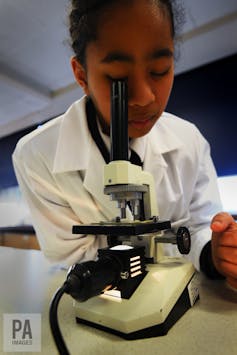In UK universities there are far fewer women in senior posts than men – particularly at professor level. Putting aside teaching, to reach this status, an academic typically needs to have completed a considerable amount of research. Research takes time, and if people want to succeed in academia, they have to apply for funding. This is where one key difference lies.
Women receive less funding than men, and they also apply for smaller grants than their male counterparts. Our study investigated the amount of research funding awarded to male and female study leads across over 6,000 studies related to infectious disease research in UK institutions. Around 75-80% of the funding was awarded to male principal investigators – a huge difference. In addition to the differences in total sums of money, there are also clear differences in the size of the grants secured.
It’s a Catch-22
So what’s the barrier to women getting funding? It’s unlikely to be widespread gender bias from the funders themselves. One of the most famous papers that did highlight clear biases in this area was a 1997 article published in Nature which pulled no punches in highlighting the problem in the peer review process of the Swedish Medical Research Council.

But this analysis is now 20 years old and does seem to be an outlier in an increasing pool of evidence. Most other analyses suggest there is no observable gender bias on the part of the research funders. For example, evidence reported by the Foundation for Science and Technology suggested there is no significant difference in the proportions of successful grant applications led by male and female researchers from the major UK funders, such as the Wellcome Trust and the Medical Research Council.
So why are women getting less by way of grant amounts? With seniority comes big bucks. The more senior the person applying, the bigger the grant they are likely to be requesting. But with fewer senior women out there to apply for something big, it’s a Catch-22.
There are initiatives within, and involving, universities that may help. The Athena Swan programme encourages institutions to consider inequalities and disadvantaged groups, and often focuses on the issues surrounding women in science. There is some evidence to suggest it is having a positive effect. The National Institute for Health Research (NIHR), one of the major UK funders, now insists that university departments and faculties must have at least a silver award from Athena Swan to be eligible to apply for their funding streams. Recipients of an Athena award have demonstrated through work practices and workplace philosophy their commitment to gender equality and supporting women in STEM careers.
There is also an interesting clause in the guidance of the NIHR autumn 2017 call for research professorships (a prestigious and significant award in the career of any aspiring health researcher). Institutions can put forward a maximum of two candidates, and at least one of the two candidates must be female.

I am not aware of other major research funders yet taking a similar approach (though they may do). It would be interesting to hear their views. As universities are increasingly strapped for cash, research income is important, so no doubt many faculties would be happy to jump through hoops to be eligible for all funding streams from the big players.
Still a man’s world?
Funding applications aside, there are good reasons for female academics to be disheartened about their chances of competing on a level playing field. A 2012 US-based study revealed how identical CVs with a male name at the top were favoured over those with a female name. Then there is the evidence that female lecturers are rated lower than their male counterparts by students, without there being any obvious difference in the standard of their teaching. It takes an extra level of tenacity and determination for a woman to make it to the top in a world that is naturally skewed towards men.
There are many additional factors that come into play as to why there are clear differences between the careers of men and women in an academic environment. Digital Science’s new report, Championing The Success of Women in Science, Technology, Engineering, Maths, and Medicine (STEM), explores many of these issues from a range of perspectives, as well as considering other areas where inequality is a problem. It also examines potential ways forward, including the use of mentors, feedback from the academic community and cultural changes that ensure there are more women into senior roles.
But what is very evident is that higher education institutions can prioritise the promotion of equality and still be successful in keeping their heads above water during the ongoing storm of funding cuts, Brexit and general political disdain towards experts.
This laughable 2012 video by the European Commission to encourage teenage girls to take an interest in science underscores the kind of problems that exist in the way women are perceived in terms of science. There was some furious backpedalling by its creators soon after its release, but it is shocking to think it got approved in the first place. But at least its desperately hackneyed approach lays bare some of the sexist, outdated and demeaning attitudes that women have to endure in male-dominated environments.

